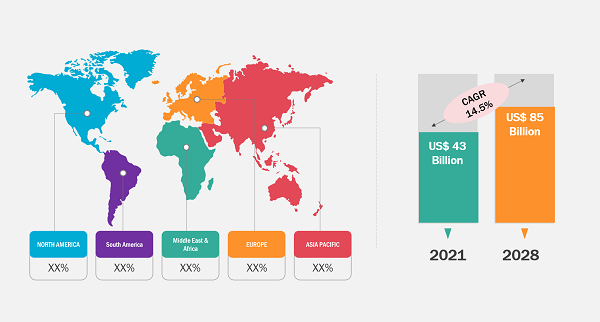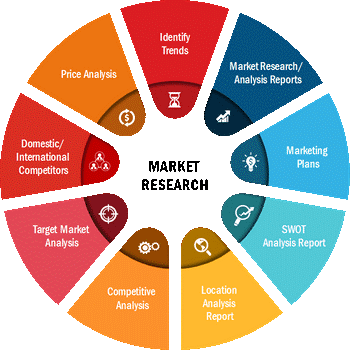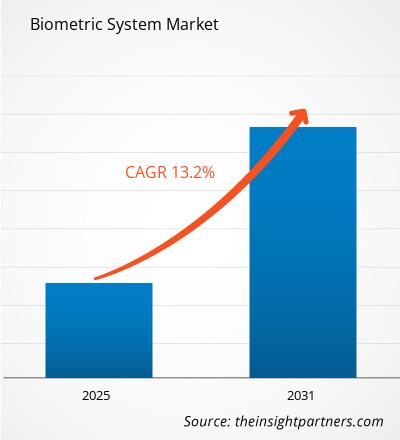2021年生物识别系统市场估值为430亿美元;预计 2022 年至 2031 年间复合年增长率 (CAGR) 为 14.5%
生物识别系统通过分析和测量指纹、虹膜、声音、面部、手形、掌纹、签名、打字模式等来对个人进行身份验证和识别。生物识别系统用于保护敏感数据并避免欺诈性使用 ATM、移动电话、智能卡、台式机、笔记本电脑和网络的访问。因此,商业和工业领域对身份验证和识别的需求不断增长,推动了生物识别系统的增长。
市场动态
生物识别系统发展的关键因素包括越来越多地采用先进技术而不是传统的基于 PIN 的方法生物识别解决方案在商业和电子商务中的应用不断增加。指纹和虹膜识别技术在办公楼和政府大楼中的部署势头强劲,以确保大量机密信息的安全。由于生物识别解决方案有助于增强安全性并限制未经授权的个人进入机场、办公场所、购物中心和其他机密空间,因此其市场在预测期内将继续增长。
< span style="font-family: verdana, generic, sans-serif; font-size: 10pt;">市场范围
全球2031 年生物识别系统市场分析”报告旨在概述生物识别系统,并根据产品、功能、身份验证类型和最终用户进行详细的市场细分。该报告提供了基于主要参与者表现的关键市场统计数据。它还提供了市场的主要趋势和机会。
战略洞察
市场细分
全球生物识别系统市场分为产品、功能、身份验证类型和最终用户。根据产品,生物识别系统市场分为硬件和软件。按功能划分,生物识别系统市场分为接触式功能、非接触式功能和组合功能。从认证类型来看,生物识别系统市场分为单因素认证和多因素认证。从最终用户的角度来看,生物识别系统市场分为 BFSI、政府、军事和医疗领域。国防、消费电子、医疗保健、汽车等。
全球生物识别系统市场分为五个主要市场地区 北美、欧洲、亚太地区、中东和非洲非洲、南美和非洲中美洲。该报告涵盖了对全球 18 个国家的分析和预测,以及上述地区的流行趋势和机遇。
从区域角度来看,亚太地区预计在 2022 年至 2031 年的预测期内将以最快的复合年增长率增长。最终用户的需求正在以惊人的速度增长,反过来又创造了对包括生物识别在内的高级安全解决方案的需求。办公楼、政府综合体、BFSI 等工业部门、医疗设施和汽车工厂的建设进一步推动了区域市场的增长。为了保护上述最终用户的机密数据,集成了语音识别、指纹扫描、虹膜识别、面部识别、心率传感器势在必行。预计这一因素将对生物识别系统市场的增长做出巨大贡献。
下图展示了全球生物识别系统市场的收入增长趋势:
 来源:Insight Partners 分析
来源:Insight Partners 分析
报告分析了驱动因素、限制因素、机会和未来趋势等因素,影响生物识别系统市场。它还对影响生物识别系统市场的因素进行了详尽的 PEST 分析。
COVID-19 大流行的影响
生物识别系统使用不同的扫描仪通过测量行为或生理模式来确认个人的身份。有一些非接触式生物识别系统不需要直接触摸即可执行测量;然而,指纹验证系统要求用户的物理外观与扫描仪进行直接物理接触,以确保系统正确读取和测量特征。需要物理存在的系统可能会增加交叉污染的机会。这一因素对基于触摸的指纹生物识别设备的普及产生了负面影响。然而,在生物识别系统的恢复阶段,不直接人为接触的生物识别系统的采用正在增加。为了遏制 COVID-19 病毒的传播,对虹膜和语音识别的需求不断增加。
市场参与者
许多公司都专注于有机增长战略,例如产品发布、产品批准、专利和活动。收购、合作和协作等无机增长战略鼓励了业务和客户群的扩张。随着生物识别系统需求的不断增长,生物识别系统市场的市场参与者预计将在未来几年经历利润丰厚的增长机会。
该报告还包括主要生物识别系统公司的简介,及其 SWOT 分析和市场策略。此外,该报告还重点关注领先的行业参与者,提供公司简介、提供的组件和服务、过去三年的财务信息以及过去五年的主要发展等信息。下面列出了一些从事生物识别系统市场的公司名单。
- Assa Abloy AB
- FaceFirst
- 富士通有限公司
- IDEMIA(Advent International)
- Iris ID, Inc.
- NEC Corporation
- 精确生物识别
- Secunet Security Networks AG
- SUPREMA
- 泰雷兹集团
Insight Partner 的专业研究和分析团队由经验丰富的专业人士组成,拥有先进的统计专业知识,并在现有研究中提供各种定制选项。
 < /跨度>
< /跨度>
- 历史分析(2 年)、基准年、预测(7 年)及复合年增长率
- PEST 和 SWOT 分析
- 市场规模价值/数量 - 全球、区域、国家
- 行业和竞争格局
- Excel 数据集


- Europe Tortilla Market
- Small Internal Combustion Engine Market
- Smart Parking Market
- Biopharmaceutical Tubing Market
- Health Economics and Outcome Research (HEOR) Services Market
- Public Key Infrastructure Market
- Blood Collection Devices Market
- Webbing Market
- Employment Screening Services Market
- Tortilla Market

Report Coverage
Revenue forecast, Company Analysis, Industry landscape, Growth factors, and Trends

Segment Covered
This text is related
to segments covered.

Regional Scope
North America, Europe, Asia Pacific, Middle East & Africa, South & Central America

Country Scope
This text is related
to country scope.
常见问题
Some of the customization options available based on the request are an additional 3–5 company profiles and country-specific analysis of 3–5 countries of your choice. Customizations are to be requested/discussed before making final order confirmation, as our team would review the same and check the feasibility.
The leading players operating in the Biometric System Market include HID Global Corporation, Bio Key International, NEC Corporation, Thales Group, Fulcrum Biometric Inc., Nuance Communication Inc., Precise Biometric, Qualcomm Technology, Dreamlog Identification System Inc., Daon Inc.
The global Biometric System Market is expected to grow at a CAGR of 13.2% during the forecast period 2024 - 2031.
Rise of Mobile Biometric Solutions, Integration of Biometric Systems with IoT Devices, Growing Adoption of Multi-Modal Biometric Systems is the key future trend of the Biometric System Market
The major factors driving the Biometric System Market is Growing Need for Enhanced Security Solutions, Technological Advancements in Biometric Technologies, Increasing Government Initiatives and Regulations.
The report can be delivered in PDF/PPT format; we can also share excel dataset based on the request.
Trends and growth analysis reports related to Electronics and Semiconductor : READ MORE..
The List of Companies
1. Assa Abloy AB
2. FaceFirst
3. Fujitsu Limited
4. IDEMIA
5. Iris ID, Inc.
6. NEC Corporation
7. Precise Biometrics
8. Secunet Security Networks AG
9. SUPREMA
10. Thales Group
The Insight Partners performs research in 4 major stages: Data Collection & Secondary Research, Primary Research, Data Analysis and Data Triangulation & Final Review.
- Data Collection and Secondary Research:
As a market research and consulting firm operating from a decade, we have published and advised several client across the globe. First step for any study will start with an assessment of currently available data and insights from existing reports. Further, historical and current market information is collected from Investor Presentations, Annual Reports, SEC Filings, etc., and other information related to company’s performance and market positioning are gathered from Paid Databases (Factiva, Hoovers, and Reuters) and various other publications available in public domain.
Several associations trade associates, technical forums, institutes, societies and organization are accessed to gain technical as well as market related insights through their publications such as research papers, blogs and press releases related to the studies are referred to get cues about the market. Further, white papers, journals, magazines, and other news articles published in last 3 years are scrutinized and analyzed to understand the current market trends.
- Primary Research:
The primarily interview analysis comprise of data obtained from industry participants interview and answers to survey questions gathered by in-house primary team.
For primary research, interviews are conducted with industry experts/CEOs/Marketing Managers/VPs/Subject Matter Experts from both demand and supply side to get a 360-degree view of the market. The primary team conducts several interviews based on the complexity of the markets to understand the various market trends and dynamics which makes research more credible and precise.
A typical research interview fulfils the following functions:
- Provides first-hand information on the market size, market trends, growth trends, competitive landscape, and outlook
- Validates and strengthens in-house secondary research findings
- Develops the analysis team’s expertise and market understanding
Primary research involves email interactions and telephone interviews for each market, category, segment, and sub-segment across geographies. The participants who typically take part in such a process include, but are not limited to:
- Industry participants: VPs, business development managers, market intelligence managers and national sales managers
- Outside experts: Valuation experts, research analysts and key opinion leaders specializing in the electronics and semiconductor industry.
Below is the breakup of our primary respondents by company, designation, and region:

Once we receive the confirmation from primary research sources or primary respondents, we finalize the base year market estimation and forecast the data as per the macroeconomic and microeconomic factors assessed during data collection.
- Data Analysis:
Once data is validated through both secondary as well as primary respondents, we finalize the market estimations by hypothesis formulation and factor analysis at regional and country level.
- Macro-Economic Factor Analysis:
We analyse macroeconomic indicators such the gross domestic product (GDP), increase in the demand for goods and services across industries, technological advancement, regional economic growth, governmental policies, the influence of COVID-19, PEST analysis, and other aspects. This analysis aids in setting benchmarks for various nations/regions and approximating market splits. Additionally, the general trend of the aforementioned components aid in determining the market's development possibilities.
- Country Level Data:
Various factors that are especially aligned to the country are taken into account to determine the market size for a certain area and country, including the presence of vendors, such as headquarters and offices, the country's GDP, demand patterns, and industry growth. To comprehend the market dynamics for the nation, a number of growth variables, inhibitors, application areas, and current market trends are researched. The aforementioned elements aid in determining the country's overall market's growth potential.
- Company Profile:
The “Table of Contents” is formulated by listing and analyzing more than 25 - 30 companies operating in the market ecosystem across geographies. However, we profile only 10 companies as a standard practice in our syndicate reports. These 10 companies comprise leading, emerging, and regional players. Nonetheless, our analysis is not restricted to the 10 listed companies, we also analyze other companies present in the market to develop a holistic view and understand the prevailing trends. The “Company Profiles” section in the report covers key facts, business description, products & services, financial information, SWOT analysis, and key developments. The financial information presented is extracted from the annual reports and official documents of the publicly listed companies. Upon collecting the information for the sections of respective companies, we verify them via various primary sources and then compile the data in respective company profiles. The company level information helps us in deriving the base number as well as in forecasting the market size.
- Developing Base Number:
Aggregation of sales statistics (2020-2022) and macro-economic factor, and other secondary and primary research insights are utilized to arrive at base number and related market shares for 2022. The data gaps are identified in this step and relevant market data is analyzed, collected from paid primary interviews or databases. On finalizing the base year market size, forecasts are developed on the basis of macro-economic, industry and market growth factors and company level analysis.
- Data Triangulation and Final Review:
The market findings and base year market size calculations are validated from supply as well as demand side. Demand side validations are based on macro-economic factor analysis and benchmarks for respective regions and countries. In case of supply side validations, revenues of major companies are estimated (in case not available) based on industry benchmark, approximate number of employees, product portfolio, and primary interviews revenues are gathered. Further revenue from target product/service segment is assessed to avoid overshooting of market statistics. In case of heavy deviations between supply and demand side values, all thes steps are repeated to achieve synchronization.
We follow an iterative model, wherein we share our research findings with Subject Matter Experts (SME’s) and Key Opinion Leaders (KOLs) until consensus view of the market is not formulated – this model negates any drastic deviation in the opinions of experts. Only validated and universally acceptable research findings are quoted in our reports.
We have important check points that we use to validate our research findings – which we call – data triangulation, where we validate the information, we generate from secondary sources with primary interviews and then we re-validate with our internal data bases and Subject matter experts. This comprehensive model enables us to deliver high quality, reliable data in shortest possible time.

 获取此报告的免费样本
获取此报告的免费样本